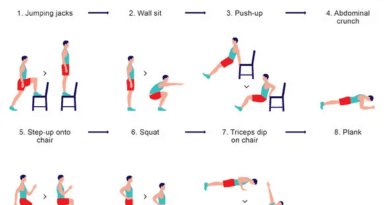The Incredible Impact of Strength Training
Strength training is a cornerstone of physical fitness that involves resistance exercises designed to improve muscle strength, endurance, and overall body composition.
Whether you’re a seasoned athlete, a fitness enthusiast, or someone just starting their fitness journey, incorporating strength training into your routine can yield a plethora of benefits, both physical and mental.
Before diving into the specifics of strength training, it’s essential to grasp the fundamentals. At its core, strength training involves exerting force against resistance to stimulate muscle growth and enhance muscular strength.
This resistance can come from various sources, including free weights, resistance bands, machines, or even body weight.
Benefits of Strength Training
1. Increased Muscle Mass: Regular strength training promotes muscle hypertrophy, leading to gains in muscle size and definition.
2. Enhanced Metabolism: Muscle tissue is metabolically active, meaning it burns more calories at rest compared to fat tissue. Thus, increasing muscle mass through strength training can boost metabolism and aid in weight management.
3. Improved Bone Health: Strength training places stress on bones, stimulating the production of new bone tissue and helping to prevent age-related bone loss and conditions like osteoporosis.
4. Enhanced Functional Strength: Strength training exercises often mimic real-life movements, improving your ability to perform daily tasks and reducing the risk of injury.
5. Boosted Confidence and Mental Well-being: Accomplishing strength training goals can lead to increased self-esteem and a sense of achievement. Additionally, exercise releases endorphins, promoting feelings of happiness and reducing stress.
Key Components of Strength Training
1. Resistance Selection: The foundation of strength training lies in selecting the appropriate resistance. This can be in the form of free weights, machines, resistance bands, or even your body weight. The key is to choose a resistance level that challenges your muscles without compromising proper form.
2. Progressive Overload: The principle of progressive overload is fundamental to strength training. Gradually increasing the resistance or intensity of your workouts ensures that your muscles are continually challenged, promoting growth and development over time.
3. Proper Form and Technique: Executing exercises with proper form is non-negotiable in strength training. It not only maximizes the effectiveness of the workout but also minimizes the risk of injury. Consider seeking guidance from a fitness professional to ensure your form is on point.
4. Frequency and Consistency: Consistency is key in any fitness endeavor. Aim for at least two to three strength training sessions per week, allowing your muscles adequate time for recovery and growth.
Types of Strength Training Exercises
1. Compound Exercises: These involve multiple muscle groups and joints, such as squats, deadlifts, and bench presses. Compound exercises are efficient for targeting multiple muscles simultaneously and are great for building overall strength.
2. Isolation Exercises: These target specific muscle groups, such as bicep curls, tricep extensions, and leg extensions. Isolation exercises are useful for targeting weaker muscle groups or achieving aesthetic goals.
3. Bodyweight Exercises: Examples include push-ups, pull-ups, and bodyweight squats. Bodyweight exercises are accessible and can be performed anywhere, making them ideal for beginners or those without access to gym equipment.
Sample Strength Training Programs
Let’s outline a basic full-body strength training program suitable for beginners:
Day 1: Upper Body Focus
1. Bench Press: 3 sets x 10 reps
2. Bent Over Rows: 3 sets x 12 reps
3. Overhead Press: 3 sets x 10 reps
4. Bicep Curls: 3 sets x 15 reps
Day 2: Lower Body Focus
1. Squats: 3 sets x 12 reps
2. Deadlifts: 3 sets x 10 reps
3. Lunges: 3 sets x 15 reps (each leg)
4. Calf Raises: 3 sets x 20 reps
Day 3:
1. Rest or Active Recovery
Day 4: Full Body
1. Pull-Ups: 3 sets x 8 reps
2. Push-Ups: 3 sets x 15 reps
3. Plank: 3 sets x 60 seconds
4. Russian Twists: 3 sets x 20 reps (each side)
Designing a Strength Training Program
1. Set Specific Goals: Whether your aim is to increase muscle mass, improve strength for a particular sport, or enhance overall fitness, setting clear and achievable goals is crucial.
2. Progressive Overload: Gradually increasing the intensity, volume, or resistance of your workouts over time is essential for continued progress.
3. Rest and Recovery: Adequate rest periods between workouts allow muscles to repair and grow stronger. Overtraining can lead to injury and hinder progress, so it’s essential to prioritize rest and recovery.
4. Nutrition: Proper nutrition, including sufficient protein intake, is vital for muscle repair and growth. Ensure your diet provides the necessary nutrients to support your strength training efforts.
Read Also How Much Does Planet Fitness Membership Costs?
Advanced Techniques to Elevate Your Strength Training

As you progress on your strength training journey, incorporating advanced techniques can take your workouts to the next level. Consider integrating the following strategies:
1. Periodization: Periodization involves planning your training in distinct phases to prevent plateaus and optimize results. Common phases include hypertrophy (muscle building), strength, and power. Adjust your training variables, such as sets, reps, and intensity, during each phase for continuous adaptation.
2. Drop Sets: Drop sets involve performing an exercise until failure and then reducing the weight to continue the set. This technique intensifies the workout, promoting muscle fatigue and hypertrophy.
3. Supersets: Supersets involve pairing two exercises back-to-back with minimal rest in between. This enhances workout efficiency and increases the intensity of your session. For example, combine bench presses with bent-over rows for an effective upper body superset.
4. Isometric Training: Isometric exercises involve holding a static position, promoting strength gains at specific joint angles. Planks, wall sits, and static lunges are excellent examples to incorporate into your routine.
5. Mind-Muscle Connection: Focus on establishing a strong mind-muscle connection during each exercise. Concentrate on contracting and engaging the targeted muscles, enhancing the effectiveness of your workouts and reducing the risk of relying on momentum.
Fine-Tuning Your Nutrition
To optimize your strength training efforts, pay close attention to your nutritional intake:
1. Protein Intake: Ensure an adequate intake of protein to support muscle repair and growth. Aim for 1.6 to 2.2 grams of protein per kilogram of body weight.
2. Hydration: Stay well-hydrated to support overall performance, recovery, and nutrient transport. Water is crucial for maintaining joint health and regulating body temperature.
3. Nutrient Timing: Consider consuming a balanced meal with a mix of carbohydrates and protein before your workout for sustained energy. Post-workout nutrition should focus on replenishing glycogen stores and facilitating muscle recovery.
Fine-Tuning Your Recovery
1. Rest and Active Recovery: Prioritize adequate rest between intense workouts to allow your muscles to recover and adapt. Incorporate active recovery techniques such as light jogging, yoga, or swimming to promote blood flow and reduce muscle soreness.
2. Foam Rolling and Stretching: Invest time in foam rolling and stretching to enhance flexibility and alleviate muscle tightness. This practice can improve joint mobility and reduce the risk of injury.
3. Sleep Quality: Optimize your sleep routine, as quality sleep is crucial for muscle repair, hormone regulation, and overall well-being. Aim for 7-9 hours of uninterrupted sleep each night.
4. Listen to Your Body: Pay attention to signals from your body. If you’re feeling fatigued or experiencing persistent soreness, consider adjusting the intensity or taking an additional rest day. Overtraining can hinder progress and increase the risk of injury.
Exploring Specialized Strength Training Programs
As you progress in your strength training journey, you may find value in exploring specialized programs tailored to specific goals. Here are a few examples:
1. Powerlifting Program: If your focus is on maximizing strength in the “big three” lifts – squat, bench press, and deadlift – consider a powerlifting program. These programs often involve lower rep ranges and higher weights, emphasizing pure strength development.
2. Bodybuilding Split: For those aspiring to sculpt and define their physique, a bodybuilding split might be ideal. This program typically targets individual muscle groups on specific days, allowing for more volume and isolation exercises to promote muscle hypertrophy.
3. Functional Strength Training: Functional strength training mimics real-life movements and improves overall performance in daily activities. It often incorporates compound exercises and focuses on enhancing mobility and stability.
4. High-Intensity Interval Training (HIIT): While not traditionally associated with strength training, incorporating HIIT into your routine can improve cardiovascular health, boost metabolism, and enhance overall conditioning. Short bursts of intense effort followed by brief rest periods characterize this style of training.
Addressing Common Concerns
1. Injury Prevention: Prioritize proper warm-ups, cooldowns, and form. If you have pre-existing conditions or concerns, consult with a healthcare professional or a fitness expert to develop a safe and effective exercise plan.
2. Plateaus: Plateaus are a natural part of any fitness journey. If progress stalls, reassess your routine, consider incorporating new exercises, or seek guidance from a fitness professional to identify areas for improvement.
3. Mind-Body Connection: Cultivate mindfulness during your workouts. Pay attention to how your body feels, celebrate achievements, and stay focused on the present moment. This mental connection can enhance the overall training experience.
Long Term Techniques to Elevate Your Strength Training
Strength training is a dynamic and ever-evolving journey. As you continue to refine your techniques, set new goals, and explore advanced strategies, remember that adaptability is key.
Our bodies respond positively to variety, so don’t be afraid to experiment with different exercises, workout structures, and training philosophies to keep things interesting and challenging.
1. Tracking Progress: To gauge your progress accurately, consider keeping a detailed training log. Record the exercises, sets, reps, and weights used in each session. This not only helps track improvements but also provides valuable insights into what works best for your body.
Periodically review your log, adjust your program accordingly, and revel in the measurable progress you’ve achieved.
2. Mindful Nutrition for Long-Term Success: Sustainable strength gains are intricately tied to proper nutrition. Ensure you’re fueling your body with a balanced mix of macronutrients, including carbohydrates for energy, protein for muscle repair, and healthy fats for overall well-being.
Consider consulting with a nutritionist to tailor your dietary intake to your specific goals and requirements.
3. Incorporating Cross-Training: While strength training is the cornerstone of your fitness routine, incorporating elements of cross-training can bring additional benefits. Activities such as yoga, Pilates, or even recreational sports can enhance flexibility, balance, and agility, complementing the gains made through your strength training efforts.
4. Aging Gracefully with Strength: Strength training is not exclusive to the younger generation. In fact, it becomes increasingly crucial as we age. Regular resistance training can help mitigate the natural loss of muscle mass and bone density, contributing to improved joint health and overall functionality.
Remember, it’s never too late to start, and the benefits extend well into the later stages of life.
5. Staying Inspired: Maintaining motivation over the long haul can be challenging. To stay inspired, consider setting both short-term and long-term goals. Celebrate small victories along the way, and don’t hesitate to reward yourself for your hard work and dedication.
Surround yourself with positive influences, whether it’s a supportive workout buddy, inspirational fitness literature, or a vibrant online community.
6. Seeking Professional Guidance: If you ever find yourself at a crossroads or facing specific challenges, don’t hesitate to seek guidance from fitness professionals. A certified personal trainer or strength and conditioning coach can provide personalized advice, correct any form issues, and help you navigate more complex training methodologies.
Conclusion:
In the grand tapestry of your fitness journey, strength training forms a vibrant and essential thread. It’s a commitment to self-improvement, a celebration of resilience, and a pathway to holistic well-being.
As you continue to sculpt both your body and mindset, remember that strength is not just a physical attribute; it’s a mindset that permeates every aspect of your life.
May your journey be filled with continuous growth, unwavering determination, and the joy of discovering your inner and outer strength. Embrace the challenges, relish the victories, and revel in the empowering journey that is strength training.
Here’s to a lifetime of health, vitality, and the enduring pursuit of your personal best. Happy lifting!
Read Also 15 Medicinal Health Benefits Of Arisaema triphyllum (Jack-in-the-pulpit)



